Welcome back to The Modern Series!
In this run of articles, I will be covering every Modern legal set from Mirrodin through Avacyn Restored, re-examining these older sets within a contemporary context. After all, many of them were designed and printed before Modern and Commander were so much as a glimmer in the eyes of their creators. If you missed my last few installments, you can check out Mirrodin here, Darksteel here, and Fifth Dawn here.
This week, we’ll be covering one of my favorite sets: Champions of Kamigawa.
Hated by most, I consider Champions to be the Back to the Future, Part III of Magic expansions. Sure, it’s not as quite as good as the other two parts (Mirrodin and Ravnica in this analogy), but wasn’t it awesome when ZZ Top showed up? And didn’t you love the part where Doc and Marty had to drive their train off the cliff?
Champions of Kamigawa at a Glance
Champions of Kamigawa, released in September of 2004, is the first set in what will almost certainly be the only Kamigawa block. Champions brought us a revamped Legend rule that was changed yet again last summer. Champions also replaced the awkward creature type ‘Wall’ with the much more elegant ‘Defender’ keyword ability while returning colored mana symbols to the text boxes of cards, walking back a terrible change that had been made during Mirrodin.
Champions of Kamigawa was arguably the first significant top-down set in Magic’s history. Kamigawa was a plane based on the mythology of feudal Japan, and we arrived on the cusp of a war between the corporeal world and the spirit kingdom. Got déjà vu? That’s probably because this is fairly similar to the plot of Theros, which also features a war between creatures of flesh and creatures of myth.
At any rate, WotC R&D delved deep into Japanese mythology to define the look and feel of the set, giving us a host of Monks, Samurai, Kitsune (Fox people), Moonfolk, and Asian dragons. Ninjas were the only major trope left on the sidelines, and at the time we all fully expected that they were being deliberately held back for the next two sets. The community was largely split on the flavor at the time. Some peopled loved the unique creature types, but others were confused by the absence of old favorites like Goblins, Zombies, and Merfolk. Unlike today’s top-down sets, where the resonant flavor still leaves room for lots of the classic creature types and fantasy tropes, Kamigawa felt like a major departure from the norm.
Champions of Kamigawa was also the first set bursting at the seams with legendary creatures since, well, Legends. This was before Commander had been created, though, so the legendary type line was a drawback with no upside at all. In order to combat this, WotC created a couple of neat ‘legendary matters’ cards, but for the most part the theme fell kind of flat. To paraphrase Syndrome, when everyone was legendary, no one was.
The two major mechanics in the set – Splice onto Arcane and Soulshift – were designed to represent the abilities of the spirit world. The spells that the spirits used were all arcane, and you could chain them to each other if you had more than one in your hand and enough mana to do so. Soulshift represented the incorporeal nature of spirits, and it allowed you to return another spirit from the graveyard to your hand when a spirit with high enough Soulshift died.
Both mechanics were fun to draft and led to lots of long and grindy matches, but they were unpopular with casual and Constructed players alike. Because Splice and Soulshift only worked with other spirits and arcane spells, both abilities were useless when you weren’t playing with a bunch of other spirits or arcane spells. These cards didn’t play well either as constructed role-players or in casual decks that weren’t dedicated to splicing or spiritcraft. More than anything else, this issue is what led to the overall dislike people have of this set. While Kamigawa Block gave us a bunch of powerful Constructed cards, an overwhelming number of the rares still feel completely dead outside that specific environment.
Champions of Kamigawa also gave us flip cards, the precursor to Innistrad’s double-sided Werewolves. Unlike the Werewolves, Kamigawa’s flip cards were generally seen as clunky and inelegant. Some of them were fairly powerful and beloved nonetheless – Nezumi Graverobber still shows up in cube play, and Jushi Apprentice was a major Draw-Go enabler in its day.
In draft, Dampen Thought was the preferred archetype by many pros, allowing players to run essentially creature-free mill decks that would continually chain spells with Splice onto Arcane. Bushido-based RW Samurai decks were also popular, as were GB spiritcraft decks that looped midrange creatures for days. It may just be the veil of nostalgia talking here, but I would rate triple-CHK as one of the better draft formats of the past decade.
Champions of Kamigawa booster boxes currently sell for a whopping $350 here on Star City, fat packs go for $120, and individual booster packs book for $10 each. This mostly has to do with the fact that the most expensive card in the set – Sensei’s Divining Top – is an uncommon. Because the price for sealed product is so high, though, I cannot recommend buying it either for fun or as an investment. If you want to draft Champions of Kamigawa, you’ll have to do so on MTGO.
And now, the cards:
Sensei’s Divining Top – $30
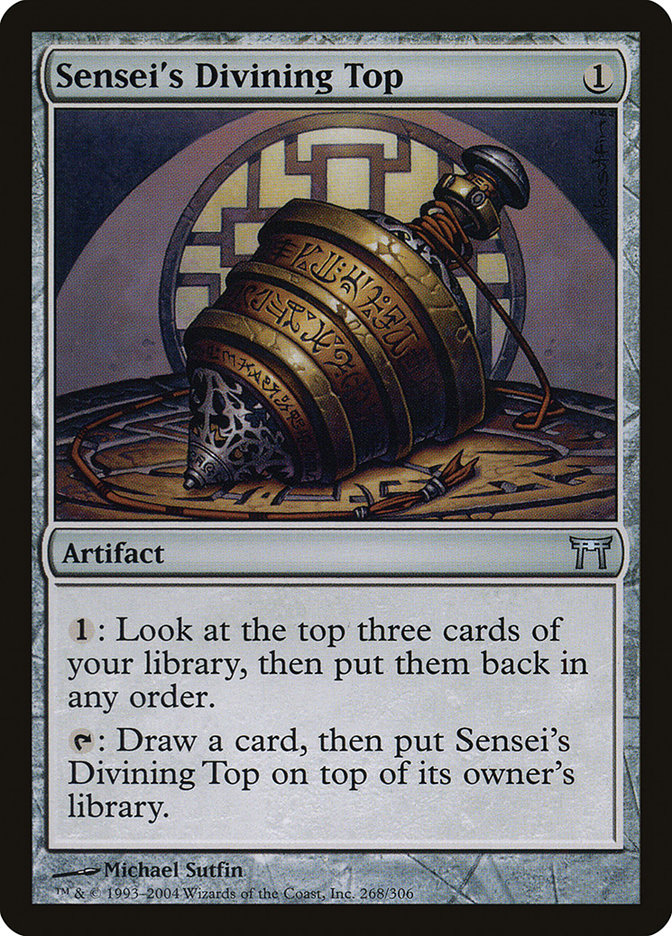
Sensei’s Divining Top was shooting upward several years ago, but From the Vault: Exiled did a decent job stunting the card’s growth in the short term. That box set is five years old now, though, and that version of the Top is even harder to get than the Champions version. It sells for a robust $55.
Banned in Modern because it makes games last an eternity, Sensei’s Divining Top will probably never be allowed back into the most popular eternal format. It’s a powerhouse in Legacy and Commander, though, turning every fetchland activation into a pseudo-Ancestral Recall and enabling Counterbalance lockdowns.
Unless WotC reprints the Top, the sky is the limit here. The card is unlikely to ever stop seeing play in Legacy and Vintage, and even if it does, casual players will still want these. A judge foil wouldn’t help, nor would it appear in a Modern Masters expansion, so it would probably need to show up in a product like Conspiracy or a Commander box set. Luckily for the Top-less out there, though, this seems like it would be a perfect fit in either environment. Sensei’s Divining Top is an uncommon, so any additional printing would drop the card from $30 down to $4 or $5 unless WotC reprinted the card at rare like they did with Aether Vial, which is certainly a possibility. If they did that, the new price would probably be in the $12-$15 range.
If you have any extra Tops lying around, now is a fine time to think about moving them. Non-Reserved List uncommons rarely break $15, and the demand for this card is real enough to get you some really nice trade offers in return. I’m not selling the copies of this I have in my casual decks, though – even if Sensei’s Divining Top does get reprinted, I’ll always need a copy or two of this to spin in Commander.
Glimpse of Nature – $30
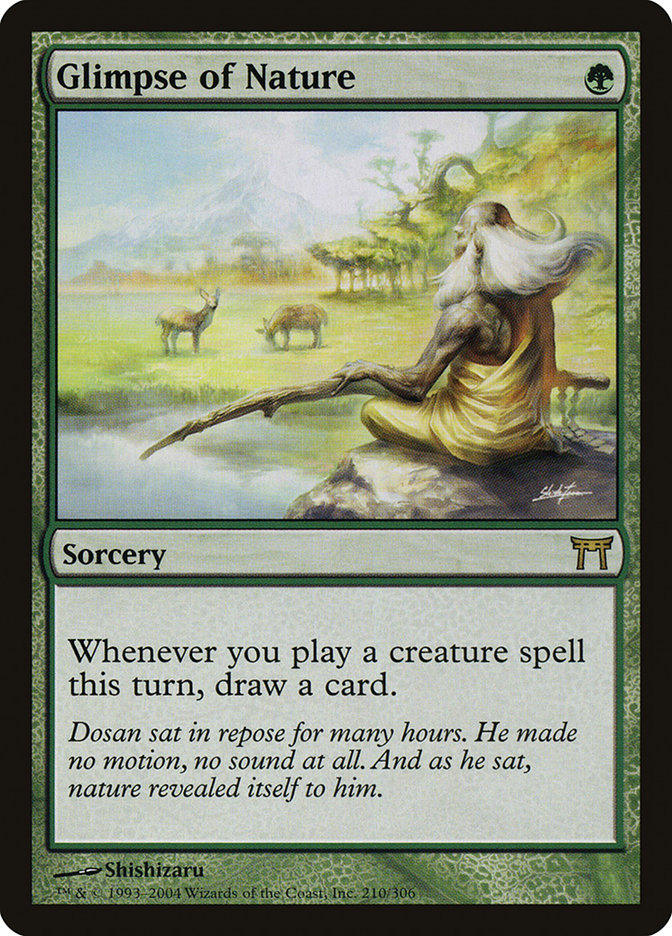
We’re two for two so far on cards from Champions of Kamigawa that are banned in Modern. Who said that this was an underpowered set?
Glimpse of Nature was a bulk rare for years, and it wasn’t until the Elves deck rose to prominence during Shadowmoor that the card spiked. Even now, Glimpse of Nature is really only played in that one deck, which severely limits its upside.
Glimpse of Nature would probably be a strong $60 if it were the most expensive card in a budget deck. You need to run 4 copies of Gaea’s Cradle in order to play Elves, though, and that’s a $175 Reserved List staple. Unless you already have those or you’ve got $700 lying around to snag a playset of them, Glimpse of Nature is going to be worthless to you.
Because of that, I don’t see much upside here. Someone might buy out the internet at try to spike the card at some point, but short of that, it will either stay at $30 or drop a little if Elves falls out of favor. If you have an extra copy of Glimpse, I suggest buylisting it. These are hard to trade because their application is so narrow.
Azusa, Lost but Seeking – $30
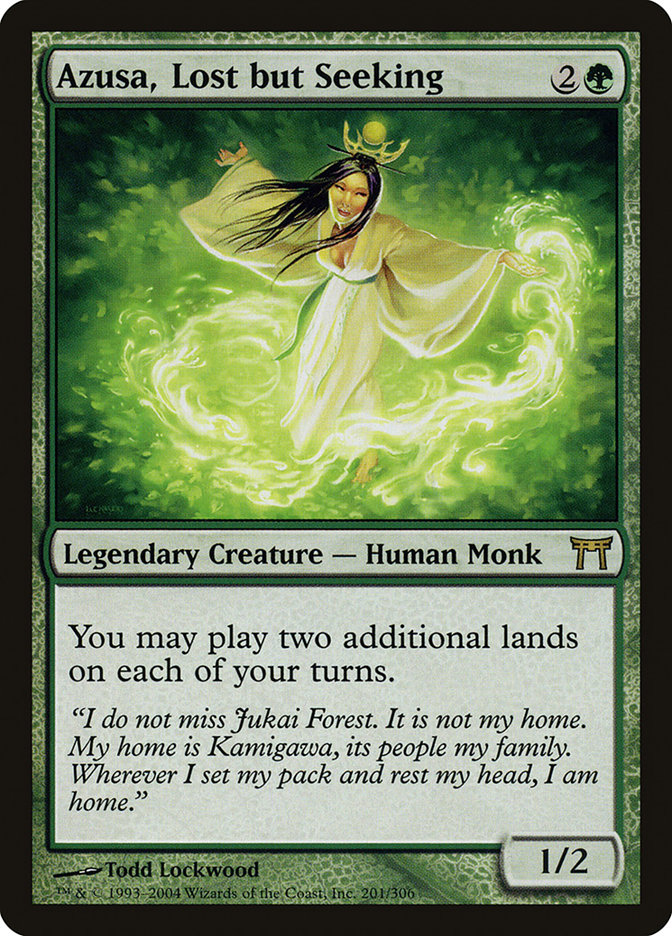
Azusa wasn’t worth half this much until late February, when Matthias Hunt’s Amulet Combo deck showed up on a Pro Tour stream. The deck looked incredible, so many of the key components – Azusa, Primeval Titan, Hive Mind, Amulet of Vigor, and more – began to spike. Unfortunately, the deck proved incredibly tricky to play correctly and was decidedly not Tier One. Interest in those combo pieces has waned considerably over the past few months.
Most of the other staples from that deck dropped at least a little, but Azusa stayed at $30. This is mostly due to how good the card is in Commander, where it provides a lightning-quick engine for green-based ramp strategies. Because interest in the card didn’t die out after Hunt’s deck lost popularity, the price stuck.
Unless the Amulet deck comes roaring back to prominence, $30 is the ceiling for this card. Azusa is one of the best Commander rares that hasn’t been reprinted, and I’d be shocked if she doesn’t show up in one of the next casual expansions or boxed set. That would drop the price down to $6 or so, making it smart to think about selling your copies of this relatively soon.
Kiki-Jiki, Mirror Breaker – $25
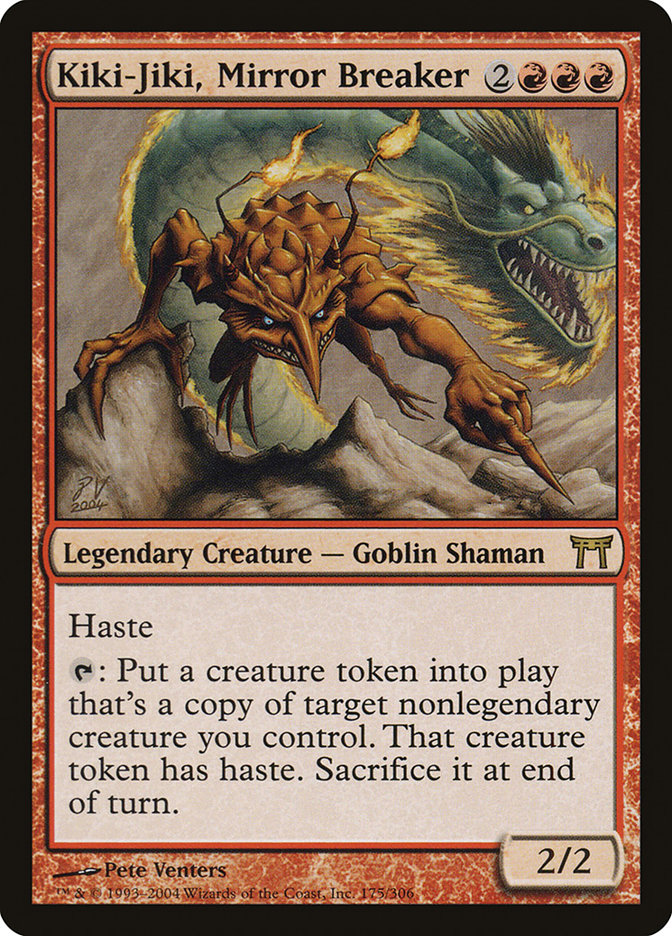
If not for the Modern Masters reprint, Kiki-Jiki would almost assuredly be the most expensive card in Champions of Kamigawa. Not only is he a casual all-star, but he’s a three-of in most Modern Kiki-Pod lists.
The argument against buying Kiki right now mostly has to do with fears of a Birthing Pod ban. There is certainly a realistic chance that this will happen – Pod is a dominant card, and repeatable tutoring is the sort of thing that WotC loves to drop the hammer on. Even if that happens, though, I’d expect Kiki-Jiki to hold his value as a casual card. Even in Commander’s worst color, Kiki-Jiki is the sort of splashy thing that casual players love to dream on. He is also irreplaceable – if you’re building a casual deck that wants Kiki-Jiki in it, nothing else will do.
If Birthing Pod doesn’t get banned, Kiki-Jiki could spike again soon. All Modern Masters cards are primed to go up, and this one was reprinted at mythic. I’m trading for these at retail right now and consider that to be a fairly low-risk, high-reward bet.
Through the Breach – $12
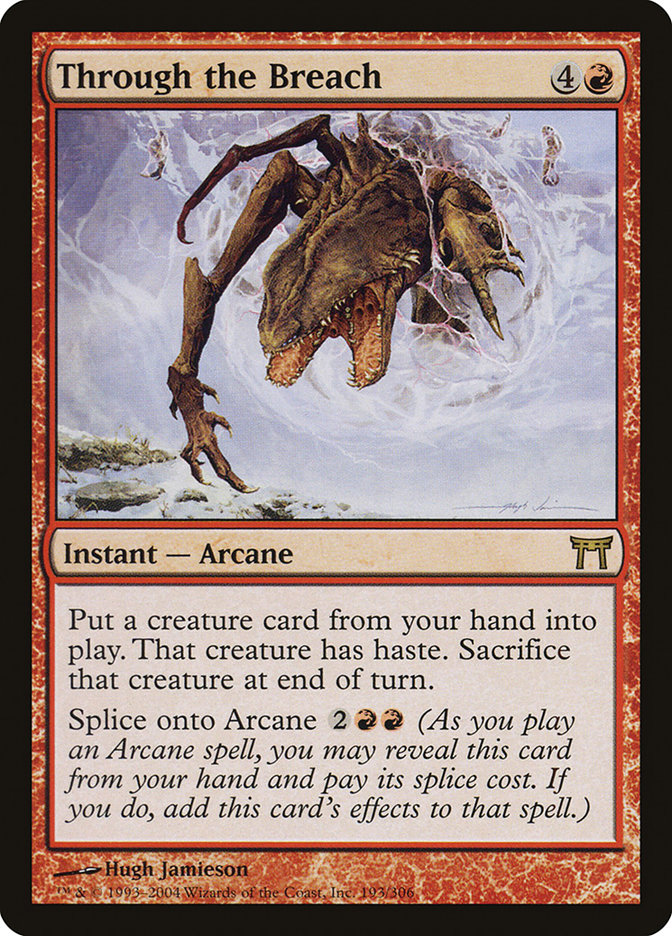
Hey, we’ve come across our first card with Splice onto Arcane. The ability is pretty useless here, though, despite Through the Breach’s high price tag. Sneak and Show decks in Legacy don’t run any other arcane spells, so this card might as well not have that ability at all.
Much like Glimpse of Nature, Through the Breach is a one-trick pony: it’s a two-of out of the Sneak and Show sideboard in Legacy, giving players another option to use when dropping a giant baddie onto the field. Other than that, it does not see play anywhere.
I can’t see the Sneak and Show strategy getting much better – it’s already Tier One in Legacy – but I suppose it’s possible that Through the Breach could become a bigger part of the strategy or simply go up in price due to more people picking up the deck. It’s also worth noting that this card is Legal in Modern while both Sneak Attack and Show and Tell are not.
Through the Breach is unlikely to be reprinted – it wasn’t in Modern Masters despite the arcane theme, and I doubt they’ll go that direction again next time. I also don’t see it as a good fit in a casual set thanks to that ability. So if a Sneak and Show-esque thing is ever going to happen in Modern, this could become a $30-$40 card easily. Otherwise, it’ll probably sit in the $10-$15 range thanks to its place in Legacy. The big risk is WotC printing a version of this without arcane that costs one mana less, thereby sending this one to the lost island of obsolete cards. I’m staying away for now.
Marrow-Gnawer – $12
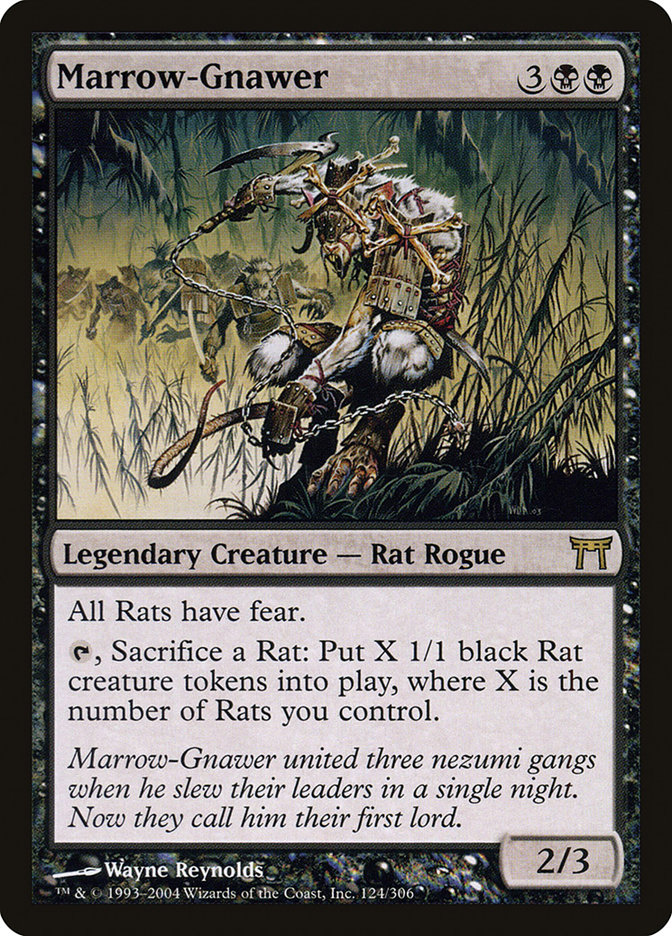
Why is a Rat Lord the sixth-most-valuable card in Champions of Kamigawa? It mostly has to do with Relentless Rats, one of only two cards in the game that let your break the four-of rule during deckbuilding. That card has fallen a little out of favor with the casual community, but for a few years building a Rat-based Commander deck was all the rage.
Why $12, though? Well, the price spiked once thanks to a buyout, and like many runs on Commander staples Marrow-Gnawer was in enough demand to sustain the price hike. This card trades pretty solidly in the $10-$12 range, but I can’t see any more upside until Rats become popular again. This is fine to hold or to trade away at retail.
Kokusho, the Evening Star – $12
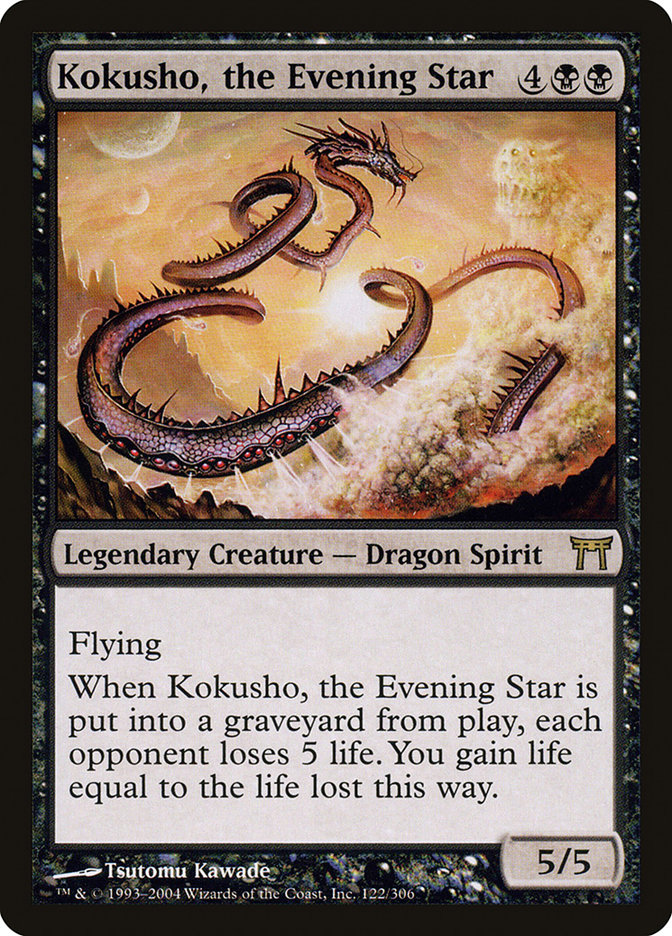
When Champions of Kamigawa was Standard legal, two cards overshadowed the rest of the set: Kokusho, the Evening Star and Cranial Extraction. Both sold briskly for $20-$25, which was the ceiling for Standard cards in those days. Kokusho was more of a casual card, but he did see a little bit of tournament play. He was hugely benefited by what was the new Legend rule at the time, allowing you to play a second Kokusho, bin both, and revel in the 20-point life swing.
Kokusho was originally banned in Commander, a decision that seems almost quaint now. Thanks to power creep, Kokusho would probably give you the life swing when he came into play instead of when he died if they printed him today. Kokusho is still somewhat popular among the casual crowd, but I haven’t had an easy time trading these away since 2010 or so. I don’t expect much movement going forward, and I expect Kokusho to stay in the $10-$15 range for the foreseeable future.
Eight-and-a-Half Tails – $10

I haven’t seen this card much on the Commander battlefield, though I’m not sure why. Eight-and-a-Half Tails may not quite measure up to your favorite nine-tailed Pokémon, but its ability is brutal on a stalled board. In multiplayer, you can sit back and use this card to protect your board from all targeted removal. Late-game, you can use it as a Falter to break through your opponent’s ranks. What more can you ask from your casual two-drop?
Like most Commander cards of this era, Eight-and-a-Half Tails’s price is being propped up by extreme scarcity. If it shows up in a pre-con, it’ll be a $2-$3 card overnight. Until then, it should be fairly stable in the $10-$12 range and could go as high as $20 if someone forces a buyout. I don’t see any tournament upside here, though, so it’s a casual spec play only.
Boseiju, Who Shelters All – $10
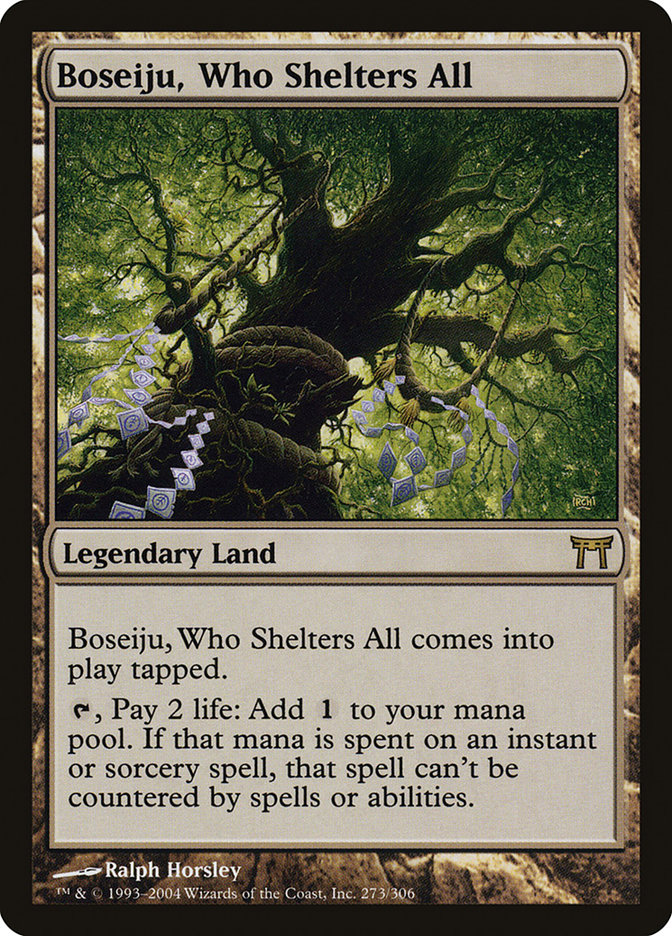
Boseiju doesn’t show up in multiples very often, but it is a fairly common one-of or sideboard card in both Modern and Legacy. Decks trying to resolve one crucial spell love it, so it tends to show up a lot in decks like Scapeshift, Sneak and Show, Ad Nauseum, and Mono-Green Wave.
At this point, the From the Vault: Realms version is easier to find than the set version. It’s cheaper, too – $8 as opposed to $10. Having seen a reprint recently, this is unlikely to see print again for quite some time. Even though it isn’t a large part of the metagame right now, I can never recommend against buying older lands that see Eternal play. This could jump to $20 or $30 and no one would be surprised, right? It’s a solid trade target at $10, but I would focus on those $8 foils.
Minamo, School at Water’s Edge – $8
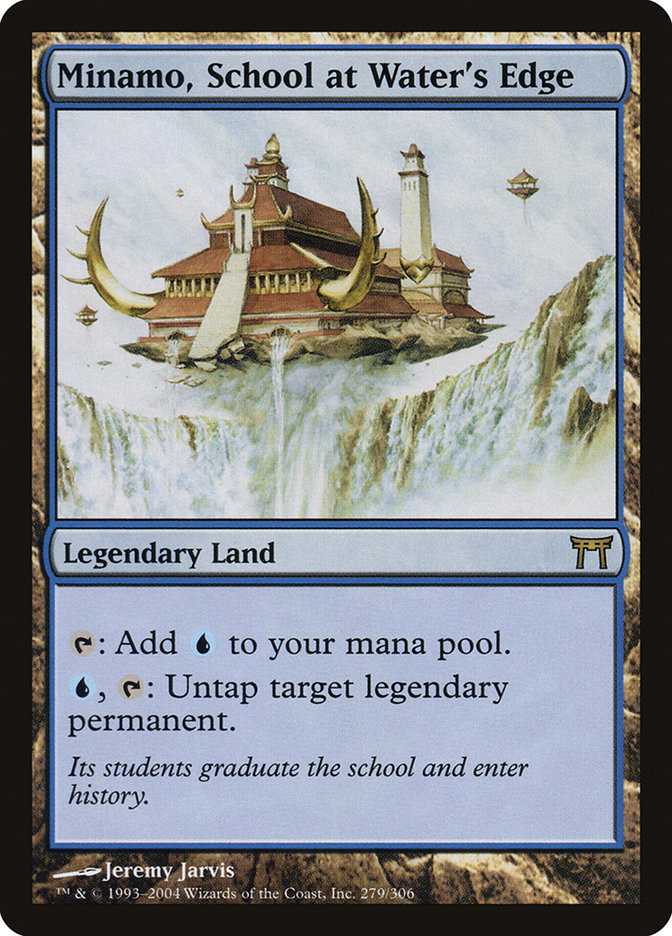
I went back to an article I wrote in December of 2010 to see what I wrote about Minamo. I remember telling everyone to buy them, but I couldn’t remember how cheap the card was at that point. You know what they were worth back then? Fifty cents. That same article also mentioned buying Gaea’s Cradle at $35 and Celestial Colonnade for $2. Oh how young and naive we all were.
For their part, Wizards is reprinting casual rares as quickly as they can, and the Minamo cycle seems like it’ll get its day in the sun at some point. If you want to invest in these in the meantime, Minamo is clearly the best one, but I’ve long believed Okina and Shizo to be undervalued.
Minamo’s ceiling, at least in terms of casual play, is probably $10-$12. Beyond that, all but the most dedicated Commander players will simply throw in an Island or another piece of fixing and call it a day, alleviating demand a little. It’s a fine card, and it will trade very well at $8, but between the limited upside and the threat of a reprint, I don’t love it as a long-term hold.
Eiganjo Castle – $8
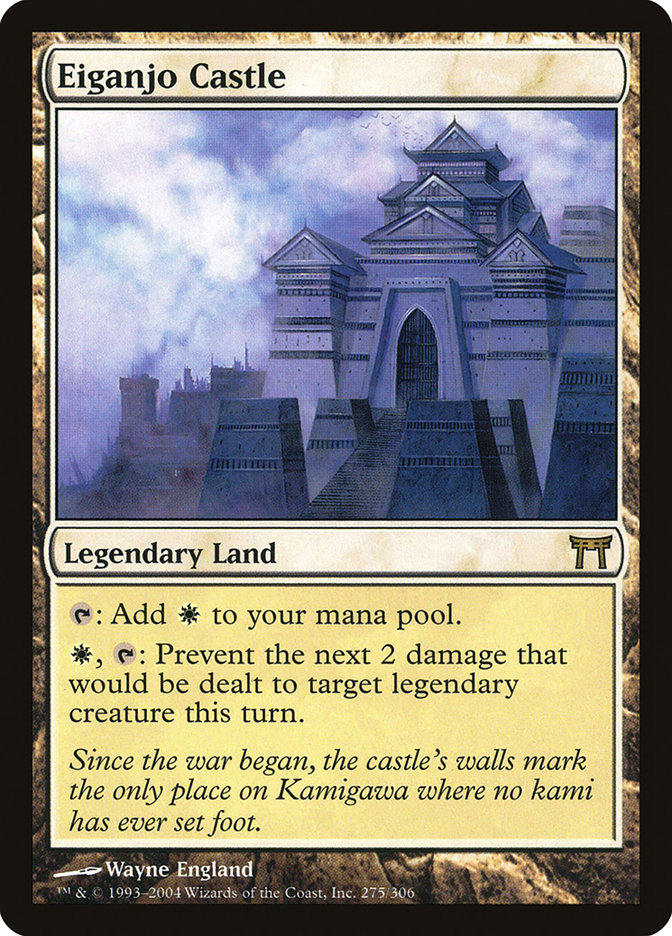
Everything I wrote about Minamo goes for Eiganjo Castle as well, except for the ease in trading them away. Minamo is easy to find a buyer for, but I’ve had three or four copies of Eiganjo Castle sitting in my binder for months and no one ever seems interested in them. If you can get close to retail for these in trade, I would.
Ghostly Prison – $8
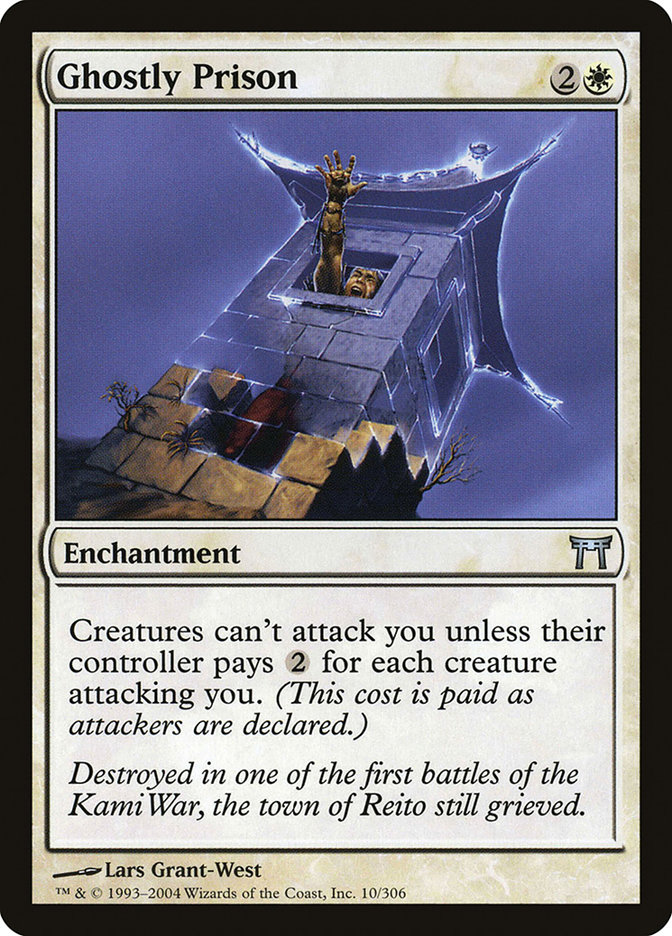
Why is Ghostly Prison $8 while Propaganda is just $2? Part of it is availability – Propaganda was just reprinted in Commander 2013, but we haven’t seen Ghostly Prison since Planechase 2012. The other part of it is Modern legality. Propaganda isn’t legal in Modern, and Ghostly Prison is a nice sideboard card out of UW and UWR control decks.
Long-term, Ghostly Prison is due to fall back into the $3-$4 range. Wizards has already brought this one back several different times, and I don’t see them stopping now. It is only a matter of time until the market is saturated once more, making this the perfect window to sell.
Konda’s Banner – $7
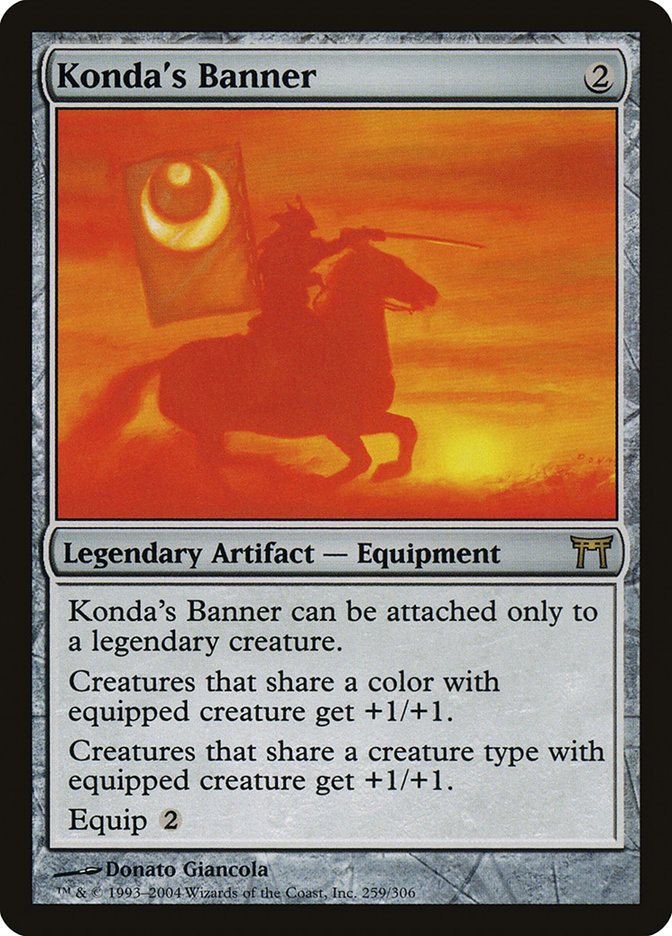
Wait, was this card actually printed before Commander was created? It totally seems like it was designed for the format, right? Konda’s Banner is great at giving an Anthem ability to a color that wouldn’t normally get it, and in a dedicated tribal deck it can provide a formidable advantage on top of that. I would go so far as to say that Konda’s Banner should be a staple in most aggressive tribal builds.
How likely is it that we’ll see a Konda’s Banner reprint soon? Flavor-wise, it’s solidly linked to Kamigawa, so it could only really come back in a limited or box set like Conspiracy or Commander 2014. That said, this card is so good at what it does in Commander that I wouldn’t be surprised to see it back at some point soon. And if it is reprinted at rare in a box set, it’ll be a $1-$2 card going forward. I’m staying away.
Yosei, the Morning Star – $6
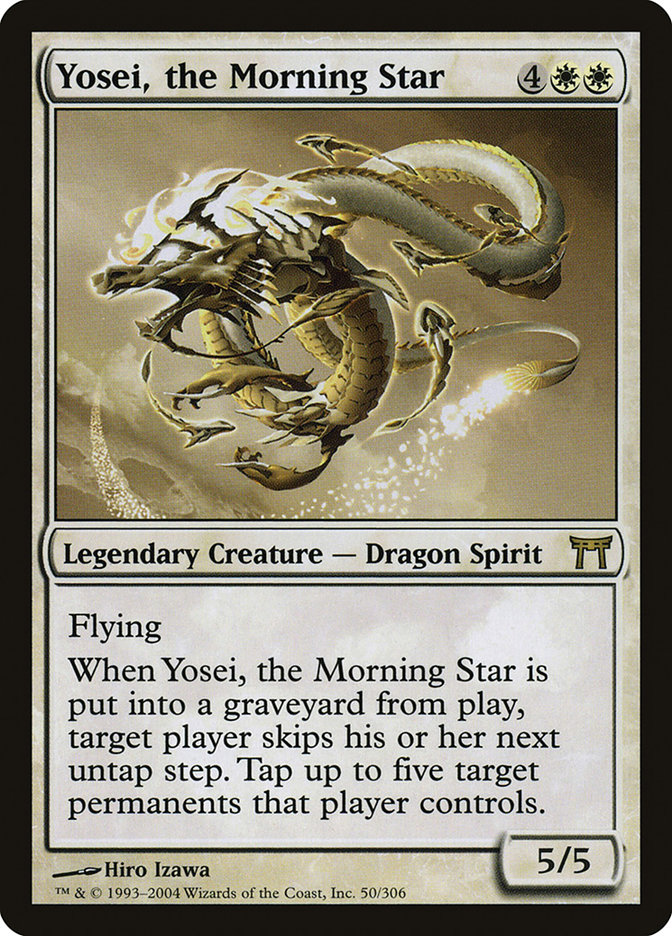
All of the Dragons (save Jugan) saw Standard play, but Yosei was the best. If your opponent got two of these out against you, it was basically a pair of Time Walks. My favorite Yosei shell ran Greater Good as a sac outlet, turning the Dragon into a card-drawing, board-stalling machine.
Yosei was creeping up on $10 before Modern Masters was announced, but the Dragon’s reprint in that set lopped the price in half. Yosei is good but not great in Commander, so the influx of new copies satiated all existing demand immediately. Anyone holding copies of similar cards like Azusa and Marrow-Gnawer should take heed.
Going forward, Yosei will probably begin another slow ascent in value as supply decreases and demand builds up again. He’s fine to hold long-term, and he isn’t likely to get much cheaper, but you’ll have to wait forever in order to make a profit so I don’t recommend buying in. There are better ways.
Shizo, Death’s Storehouse – $6
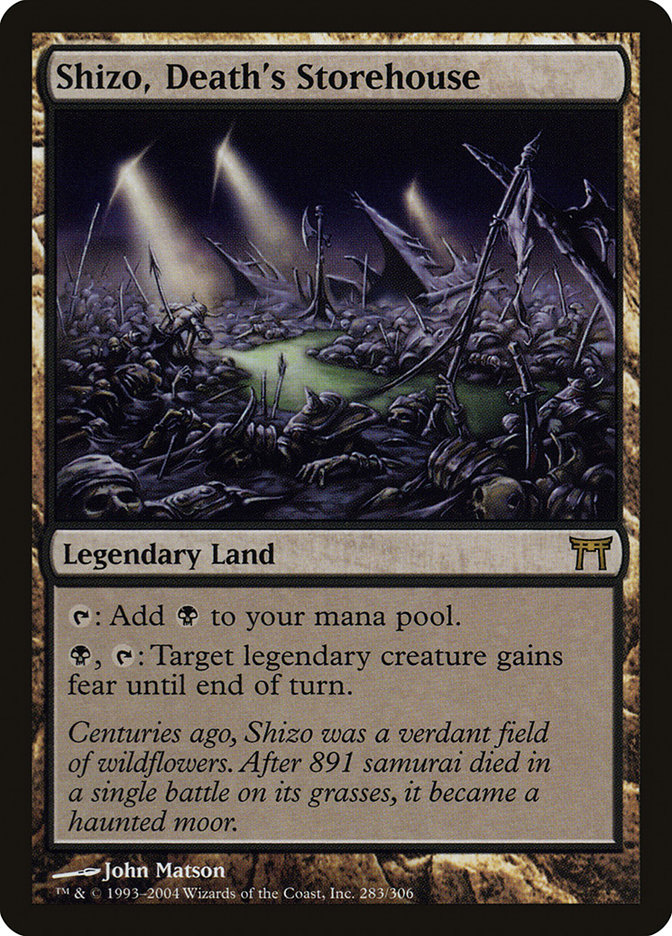
Shizo isn’t as good as often as Minamo is, but it’s quite a bit more game-breaking when it does work. These lands all got significantly better with the new Legend rule, and I wouldn’t be surprised if some of the lesser ones catch up with Minamo in the $8-$10 range at some point soon. Shizo is the most likely to make the leap, and if I were going to speculate on any of the cards in this cycle it would be this one.
Gifts Ungiven – $6
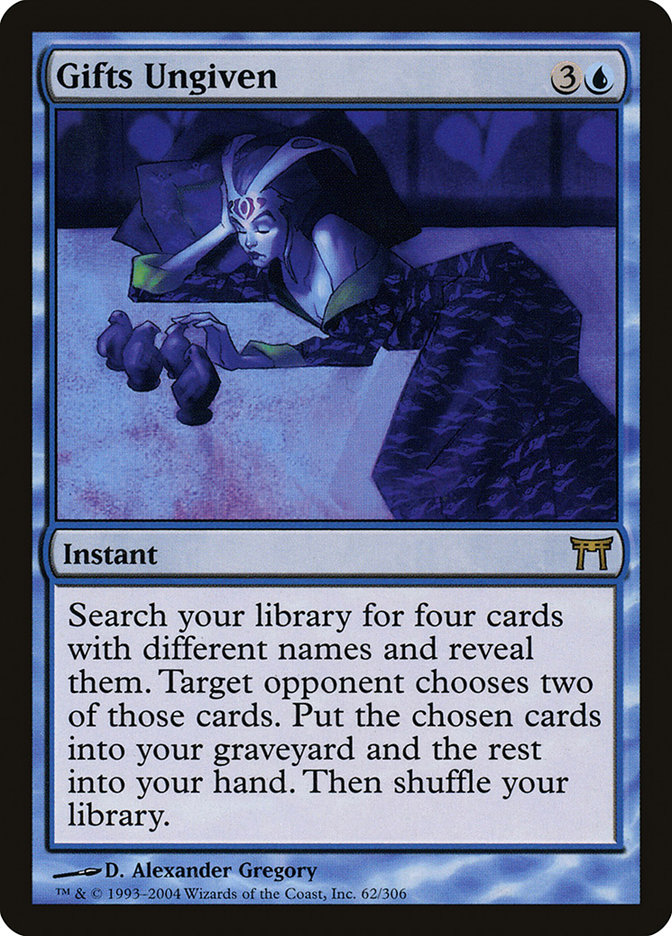
Looking for a good buy in this article? Here you go. Gifts Ungiven is very strong in Modern, appearing as a four-of in several different competitive Tron, UW Control, UWR Control, Esper Control, Gifts Control, and Gifts Rock builds. At some point, one of these decks will take down a major event and Gifts will spike to $15 or $20. Sure, it was a printed at rare in Modern Masters, but so was Cryptic Command. Oh – and the Modern Masters version of this is available for just $5.
Unfortunately, Gifts Ungiven is banned in Commander, which makes this a riskier play than it would be otherwise. If I’m wrong and Gifts doesn’t break out at any point in Modern, then you’re going to find yourself left with a fairly useless pile of blue four-drop spells. I still like it a lot, but it’s not for the risk-averse.
Forbidden Orchard – $6
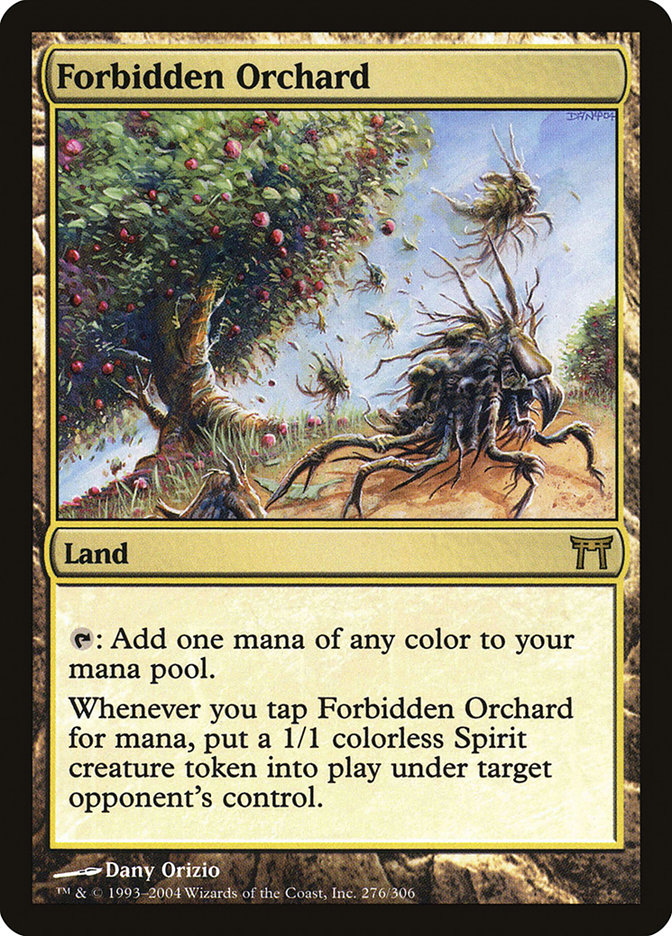
Giving your opponent a free 1/1 flier is never a good thing. The drawback is slightly less meaningful in multiplayer Commander, where you can help out a weaker opponent or play politics, but that format has more than enough good fixing already. The only real use for this card is as an Oath of Druids enabler, but Oath is banned in Legacy and if you’re playing Vintage but you can’t afford a set of Forbidden Orchards, you’ve got bigger issues.
Could Oath of Druids be unbanned in Legacy? Caleb Durward, who tested most of the banned cards in Legacy recently in a great series of videos, thinks that it’s possible. Most Legacy players I’ve spoken to about the issue disagree, though. If it does happen, both Oath and Orchard will shoot up in price by at least fivefold, so there’s some high reward potential here. It’s not the spec for me, though.
Keiga, the Tide Star – $5
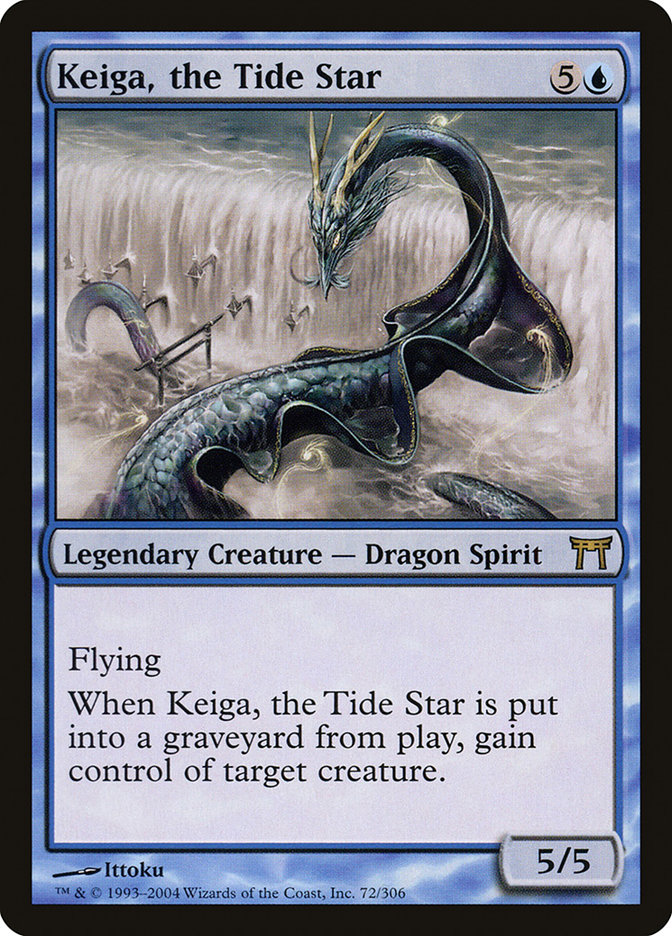
I love Keiga so much. I had a 60-card multiplayer deck back during this era that attempted to steal everything on the board, and looping Keigas for hours was a large part of it. To this day, I refuse to cut the card from my cube and will run it in my blue-based Commander decks whenever possible. When aren’t you going to want a giant Dragon that gives you a happy present when it dies?
In terms of actual playability, Keiga’s time has come and gone. Unless you are a nostalgic dork like me, there are so many better cards to run instead, even in casual formats. I doubt we’ll see this card above $5 at any point unless, I don’t know, someone burns down every other blue card that exists?
Godo, Bandit Warlord – $5
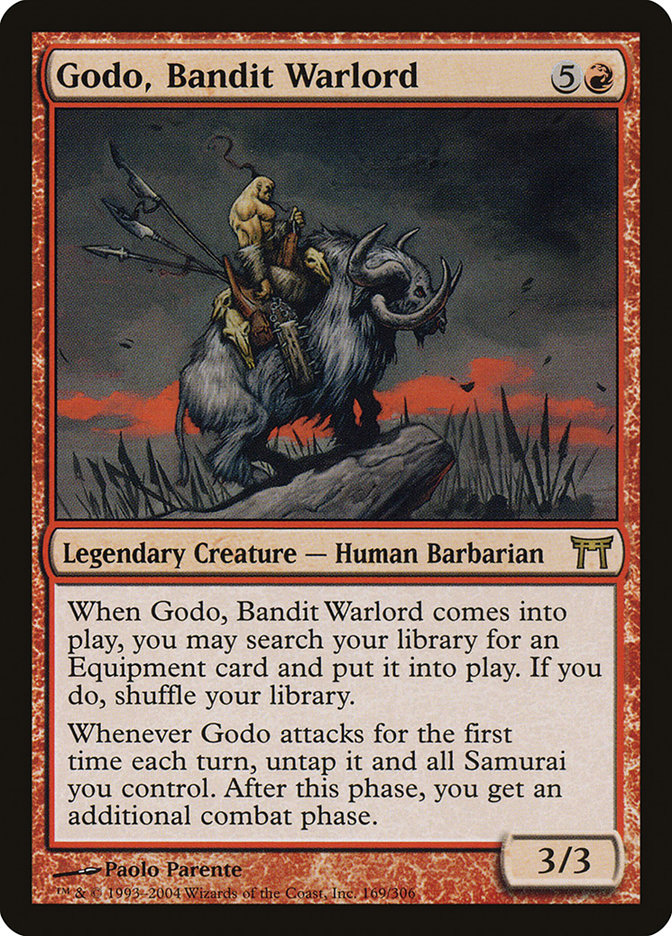
In the early days of Commander, Godo was the red Commander. Most equipment decks are based in white these days, but any deck running red and a bunch of Swords should at least consider the Bandit Warlord. Six mana is expensive, but getting to tutor something directly into play and having an additional combat phase are both huge.
Godo isn’t worth more than $5 because he’s quite narrow, but that fact also makes a reprint less likely than many of the other Commander cards on this list. I could see him hitting $8-$10 fairly easily, but he’s also going to be hard to trade away, so tread lightly.
Nezumi Shortfang – $4
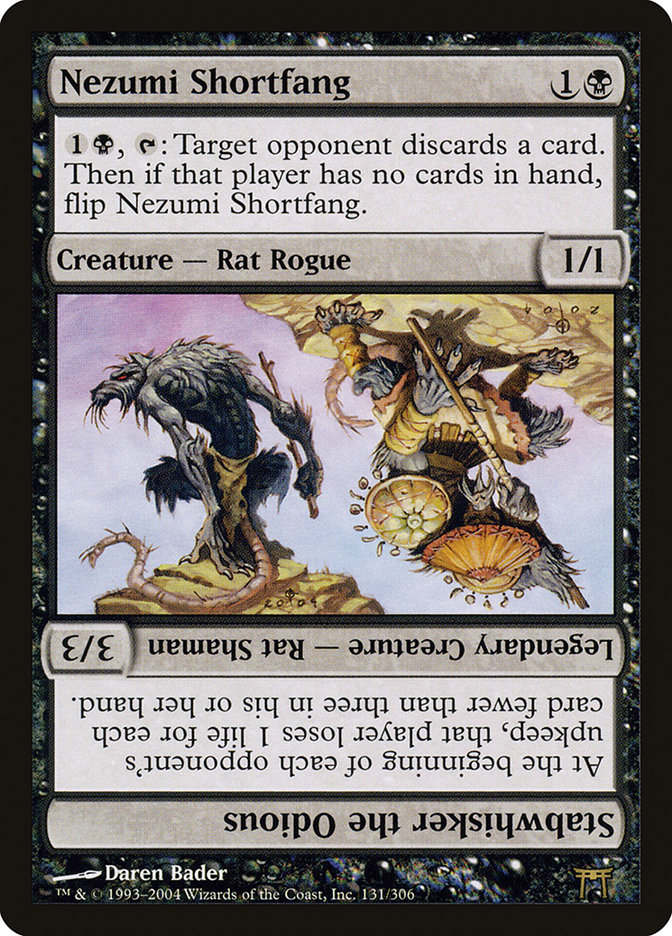
Nezumi Shortfang is okay in large cubes and certain narrow Commander decks, but it doesn’t have much upside in either. It’s too slow for Modern and Legacy, and it’ll never be reprinted in Standard. Shortfang might go up in price simply due to scarcity – they’re never reprinting flip cards – but I wouldn’t invest in these based on playability alone.
Seizan, Perverter of Truth – $4
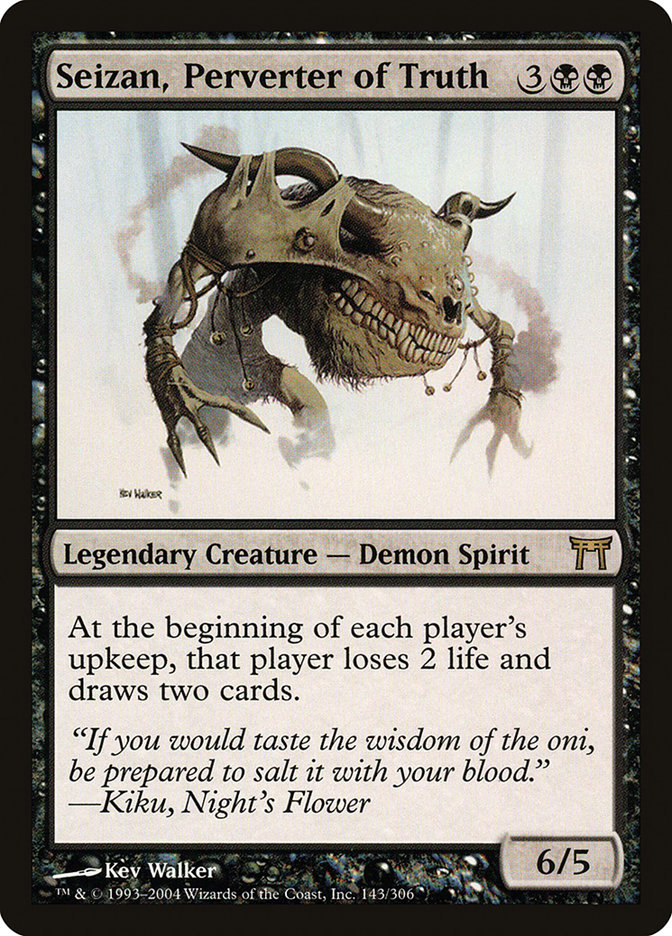
Seizan jumped to $4 for one reason: Nekusar, the Mindrazer. If that deck continues to be popular in Commander, this card could jump as high as $8, similar to how Forced Fruition did. Without Nekusar, Seizan is solid but unspectacular. He’s unlikely to make the cut in most other decks.
Myojin of Life’s Web – $4
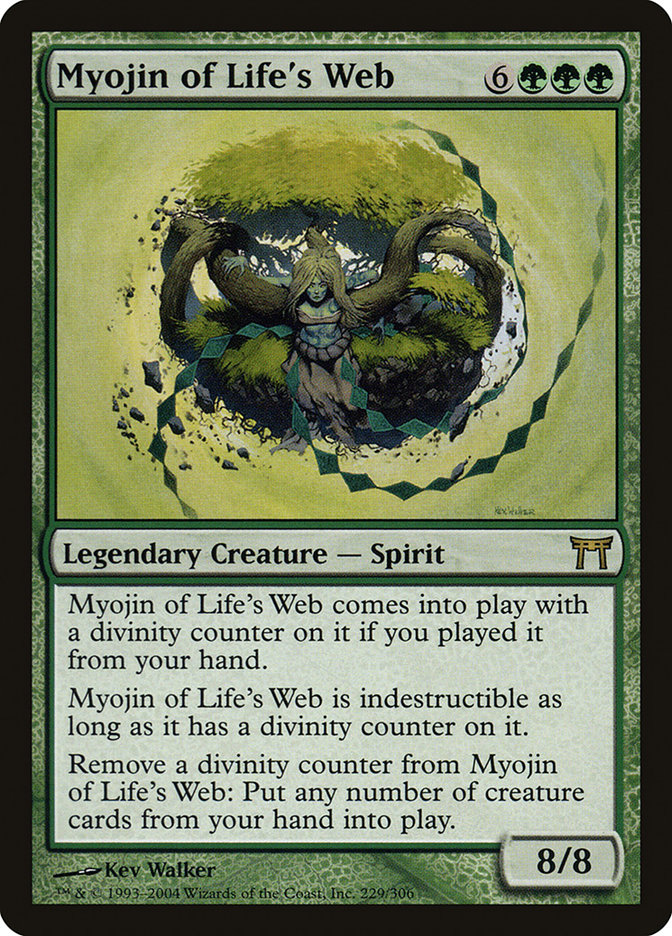
The Myojin are very frustrating. There’s no way to cheat them into play and have them be at all useful, so you basically have to ramp for days if you want to have any fun with them. By the time you get Myojin of Life’s Web out, you should have the mana to be able to cast everything else in your hand as well. In Commander, though, some green decks will be able to draw a gripful of gas and use this to dump it all out at once. That’s fine, but it’s still sort of narrow and hard to use compared with something like Genesis Wave. Long term, I’m not a fan.
Konda, Lord of Eiganjo – $4
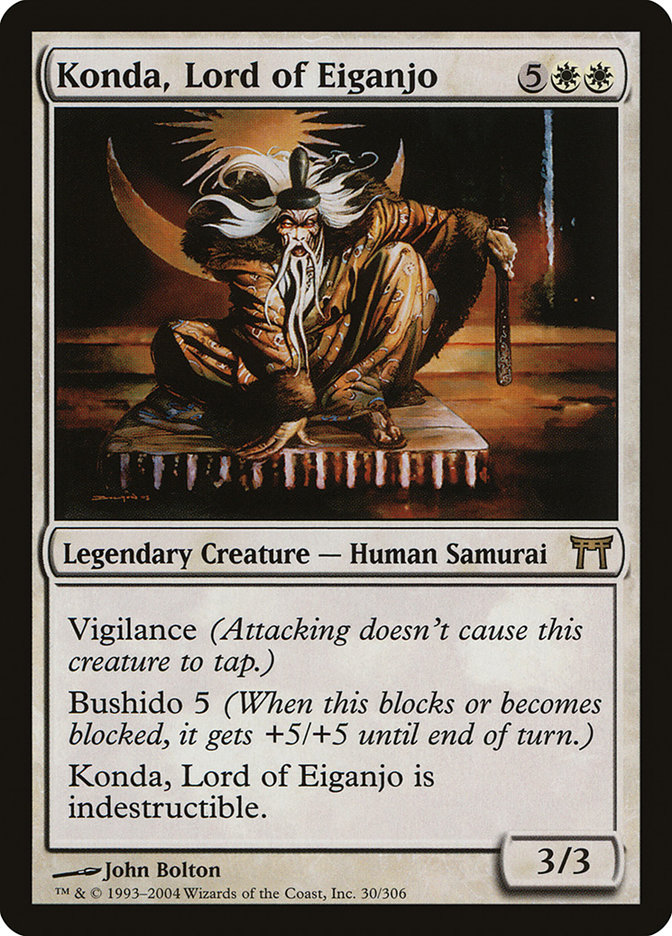
Bushido was another panned Kamigawa keyword. The flavor was spot-on, but in a pre-New World Order environment, blocking was kind of lousy. These days, blocking is fine – and Konda does it really, really well. In Commander, this is the sort of card you want to have in play, rattle-snaking your opponents and forcing them to look elsewhere for a profitable attack. I could see this card going up even further if he was even slightly cheaper, but seven mana means that you either have to ramp a lot or you’re hoping to cheat Konda into play somehow. That’s narrow enough to eliminate most of the upside here.
Isamaru, Hound of Konda – $4
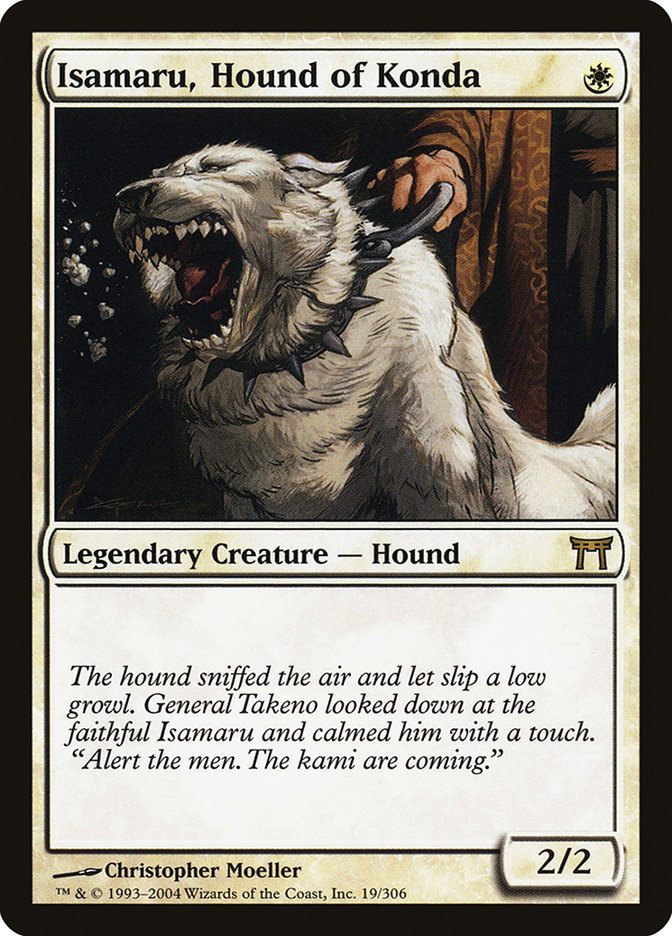
There is a Modern Hate Bears deck that uses Isamaru, but it’s way out on the fringes of the format. Otherwise, this card is limited to cube and casual Boros aggro builds. Considering how unpopular aggressive cards are in casual formats like Commander, I can’t ever recommend picking them up unless you have a specific personal need.
Hinder – $4
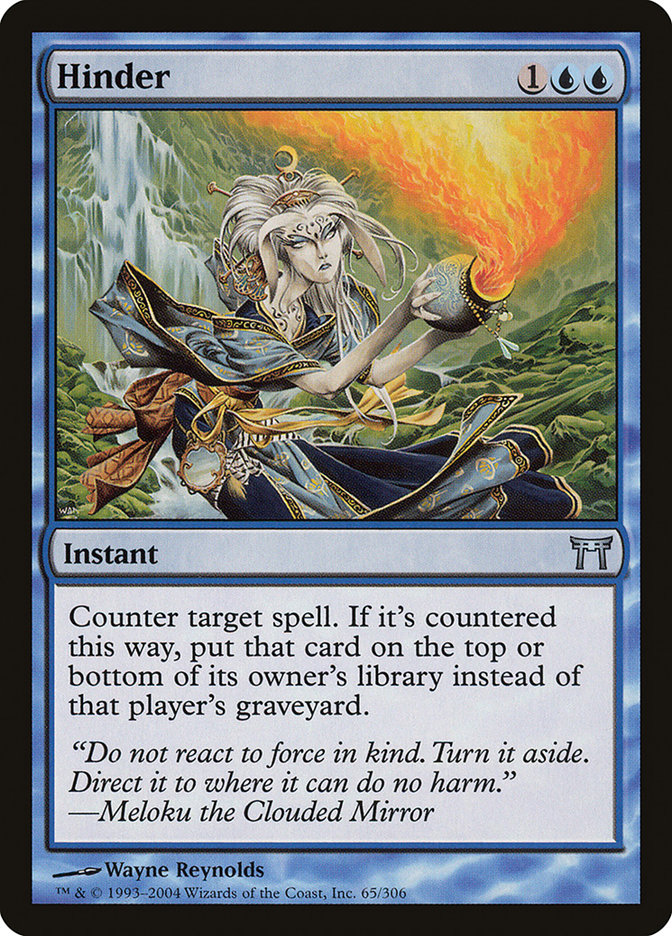
I was surprised to see this card was worth so much. It was a $1 card back when it was Standard-legal, but it’s not good enough for the Eternal formats so I figured that it had faded away into obscurity entirely. Nope – the ‘tuck’ ability makes this far better than a normal counterspell in Commander, causing the price to reach these heights. Spell Crumple from Commander 2011 is better but that card spiked in price to a whopping $8 recently, making this is a nice budget alternative.
Could Hinder hit $8 as well? I doubt it. I think Spell Crumple will be reprinted in the next box set, reducing the pressure on Hinder’s price a little regardless. Even still, I can’t see this card dropping too much without a reprint; if you’ve got bulk left over from that era, paw through it and pluck these out. Even if Hinders don’t trade well in your area, they buylist to Star City for a healthy $1.
Hall of the Bandit Lord – $4
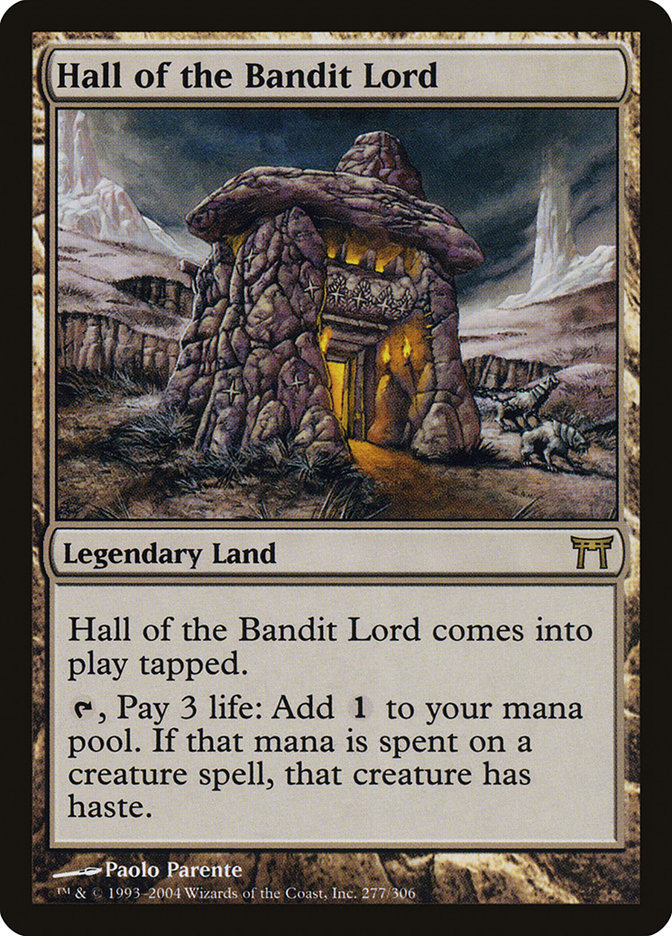
Travis Woo tried to make this one work recently, but he kept getting frustrated by it. Even in a deck built around giving creatures haste, Hall of the Bandit Lord felt both slow and bad. I can see why they didn’t want to risk making this card too good, but decks that want to abuse haste can’t deal with a land that comes into play tapped in addition to the life and colorless mana drawbacks. It’s a bridge too far.
Does Hall of the Bandit Lord have any hope? Well, I hate to dismiss any older Modern-playable land out of hand. I suppose WotC could print a creature that is so good when given haste that a deck might want to run this, but in that case, I’d rather invest in Through the Breach. This can’t go much lower – it is a unique land, after all – but any upside would likely be based around a temporary spike. In fact, that has already happened to this land once before.
Budoka Gardener – $3.50
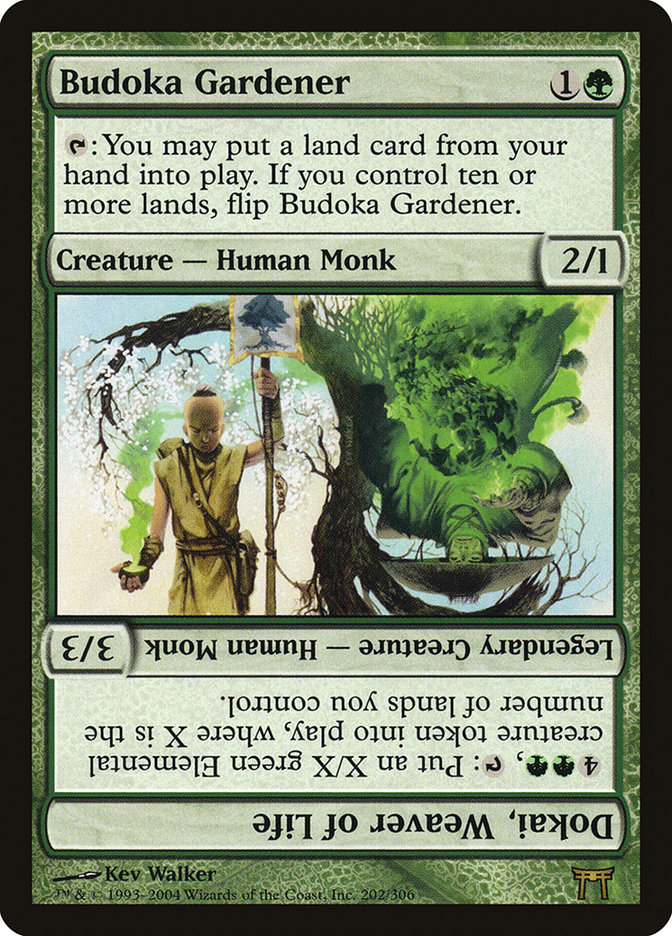
Is Azusa not enough ramp for you? Check out her friend Budoka Gardener, who provides ramp and late-game threats all wrapped up in a nice 2/1 for two mana. Green decks in Commander have a lot of options for these slots, and I tend to prefer cards that actually fetch lands from your deck like Sakura Tribe-Elder and Farseek, but there’s something to be said for the double-duty this little guy plays. I don’t think we’ll ever see these lousy looking flip cards reprinted, so the Gardener is a very safe spec at $3.50.
Tatsumasa, the Dragon’s Fang – $3
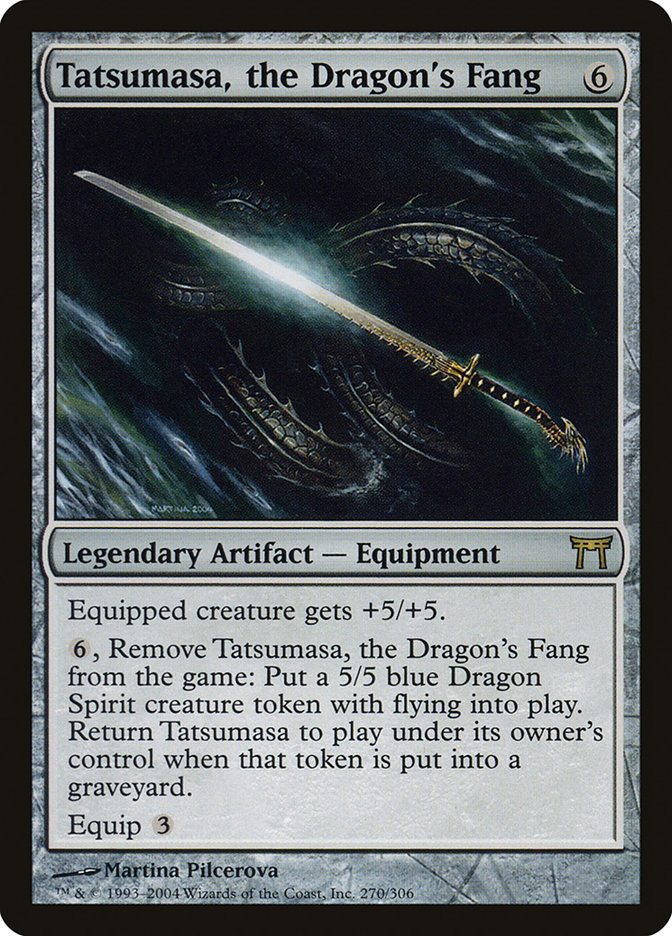
Tatsumasa is oozing with flavor. It’s also a nice target in an equipment toolbox deck, especially because it doesn’t need a creature to –
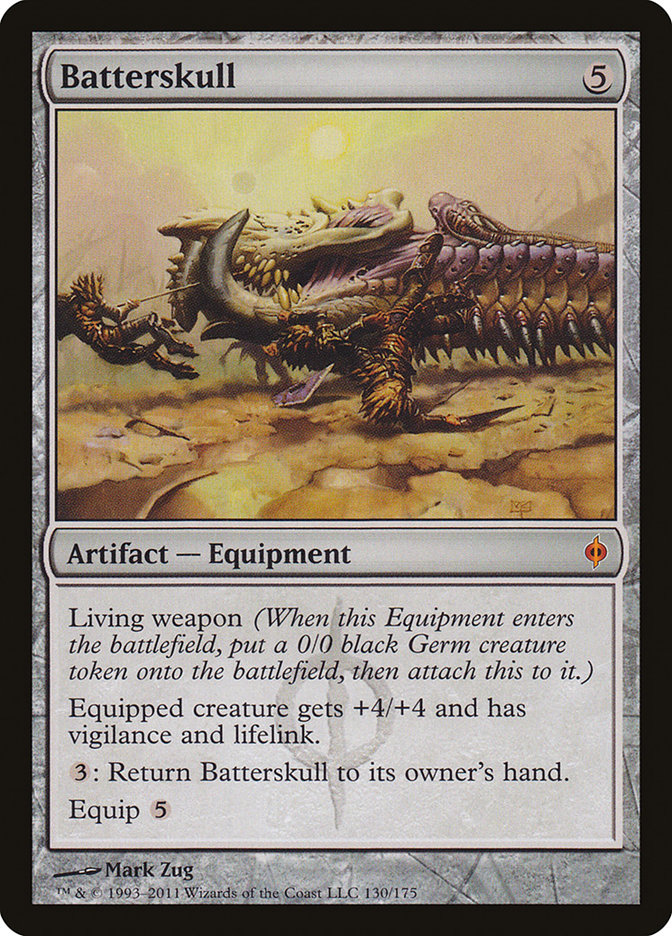
Oh. Right. That’s a card that’s better in virtually every way, which is why Tatsumasa has largely been forgotten. Did I mention how beautiful the foil is, though?
Jugan, the Rising Star – $3
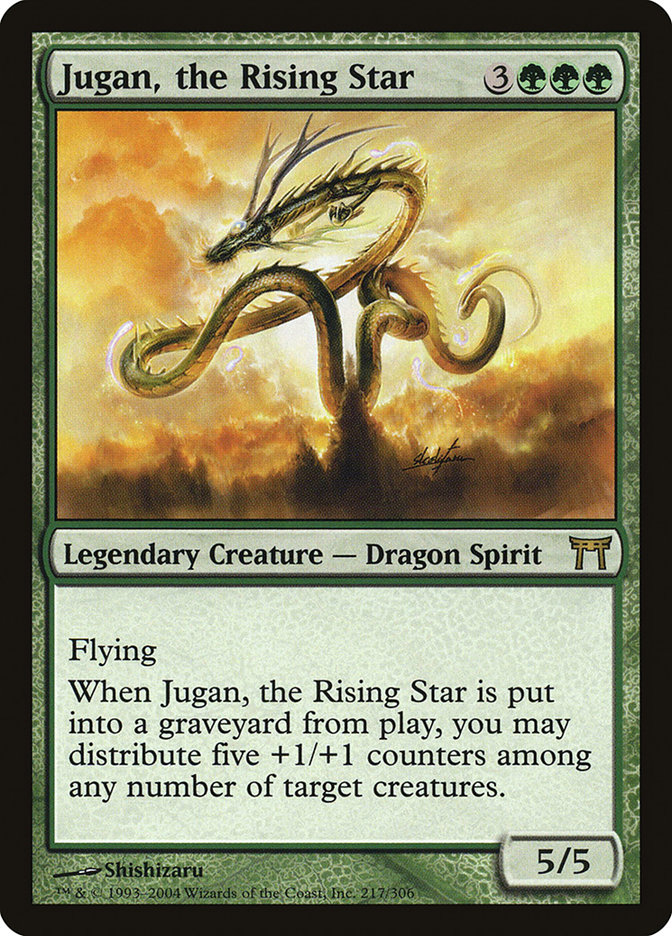
Jugan has always been the runt of the Kamigawa Dragon litter. He’s arguably the best of the five in Limited play, where his ability is a blowout and you can seek to ramp him out a turn or two early, but he’s close to worthless in any non-Limited format. Green has too many other better large creatures, and Jugan isn’t particularly sneaky or unique. Feel free to buylist your copies of this guy away.
Heartbeat of Spring – $3
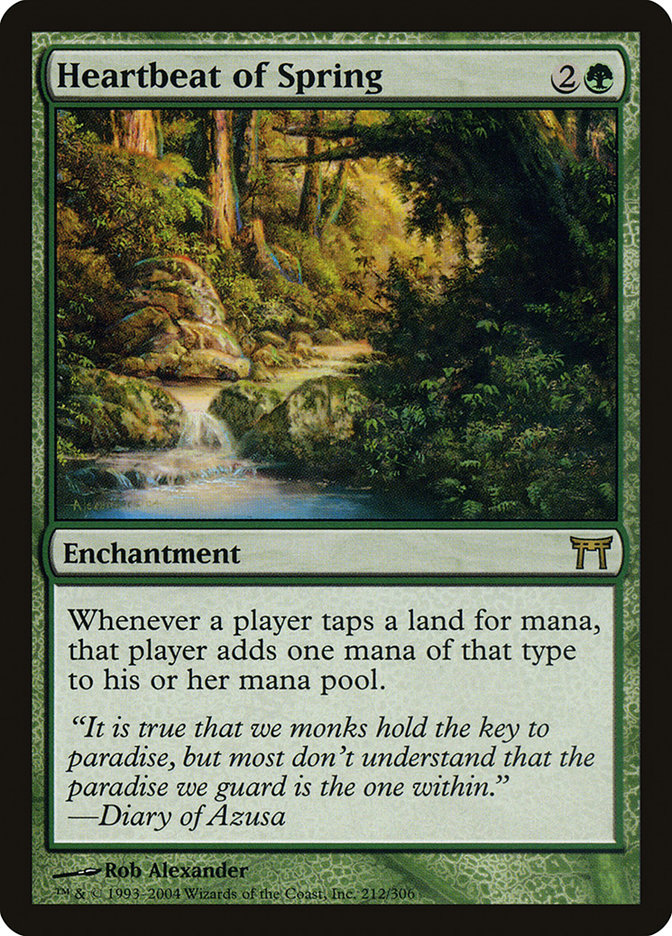
The value of this card is why I was surprised at everyone calling Dictate of Karametra a good casual spec. Sure, Dictate of Karametra gives you the ability before your opponents have a chance to abuse it, but it costs an additional two mana for that advantage. In the meantime, Heartbeat of Spring does the same thing for just three mana and $3. If casual players liked symmetrical abilities like this, Heartbeat of Spring would be up there next to Minamo and Boseiju. Face it – casual players don’t like giving their opponents an advantage. That’s why Mana Reflection is $20 and this is just $3.
From a Constructed perspective, Heartbeat of Spring showed up in Standard and even in Extended before that format was discontinued. Modern is just too explosive to give your opponent this kind of edge, though. This card has the potential to explode in value if it ever does find a home, but the chances of that actually coming to pass are very small. Unless that happens, this card will continue to be nothing more than buylist fodder.
General’s Kabuto – $3
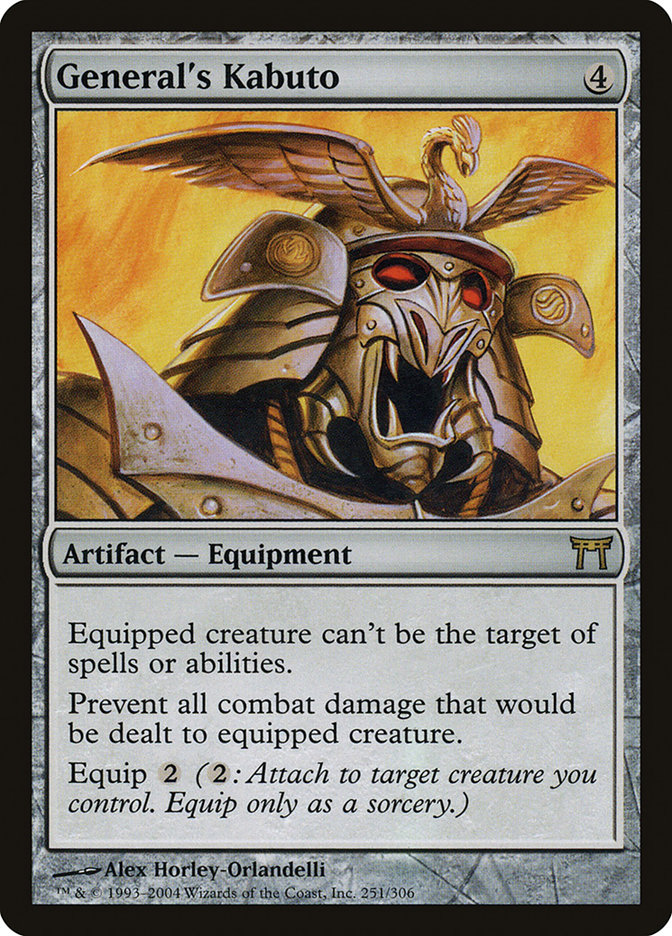
I’d rather have Lightning Greaves and Swiftfoot Boots in my deck than General’s Kabuto. Absent those two, I’d take Protective Bubble. If none of those were an option, though, I’d probably play General’s Kabuto and be reasonably happy with it. This is yet another one of those Kamigawa missed opportunities that makes the set so frustrating – if it were just a little cheaper or a little more powerful, it would be a totally fine Commander staple. As-is, it’s just a little too lousy to see play.
And that’s really the problem with this set, isn’t it? Champions of Kamigawa explores really interesting mythology, but uses that flavor to create two of the most insular and useless keyword abilities in the history of the game. Champions explores ‘legends matters,’ but does so before the advent of Commander would have given us a bunch of useful Commanders. Champions teases us with cool spells and interesting creatures, but most of them aren’t powerful enough to make the cut outside of sealed deck or draft.
And yet, I still love Champions of Kamigawa. The Dragons are cool, the draft format is a blast, the art is gorgeous, and Gifts Ungiven is one of the best cards ever designed.
Now if you’ll excuse me, I have to go watch Marty McFly win a gunfight.
